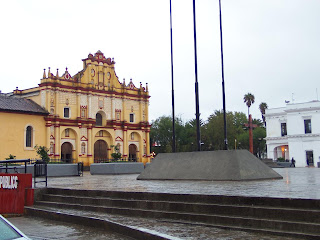Tight Spaces… and Politics
June 27, 2012
A Tzotil girl had arrived at the
museo this morning as Sergio and I were going through our daily patient list. She said her father-in-law,
su suegro, had fallen and scraped his knee and is now having swelling and a lot of pain. She described their home being in barrio Santa Cruz. We already have a patient in Santa Cruz so Sergio thought we could squeeze him in. When he asked how far up on the hill do they live she said, "
no tanto mucho" — not so much. She would wait on the main street until she saw us to take us to their house.
This is typical for the barrios; you can't find a home by an address and it’s not unusual for the resident to meet you on the street to guide you. Barrio Santa Cruz is in the southeast part of the city as the east mountains rise. If this were the US, this area would have the finest homes as the views of the city and mountainous surrounding areas are spectacular. Instead, in Santa Cruz there are concrete block or plank-wall homes with flimsy tin or tarp roofs that are more like rooms instead of homes.
 |
| The trail. |
Getting to this house was a tight squeeze up a narrow rocky trail that followed a wooden fence held together with barbed wire. Water was continuously running downhill and maintaining the moisture on this steep trail so holding on to something to avoid a fall with our medicine bags was necessary. When we arrived to the home we found
el suegro lying on his back covered with blankets. His right knee was exposed and we could easily see the problem: the pre-patella bursa (the fluid filled sac that overlays the knee cap under the skin) was infected. There was a quarter-size scab on top and this swollen mound was hot and red, the patient felt as if he had a fever and he answered, "Yes," when asked if he had chills. It appeared to me this guy was really sick, possibly becoming septic.
 |
| We had two photographers with us today who are very interested in Don Sergio's humanitarian work. |
El suegro, by the US standard of care, needed to be in the hospital, his bursa drained of infectious fluid (which would be sent for culture and sensitivity), on IV antibiotics and pain medication. But we are in los barrios de San Cristóbal and this is a Tzotzil patient. The indigenous folks do not like to go to the hospital for various reasons. One is that they have to have someone stay with them the entire time of admission to feed and monitor them, but mostly they wait until they are almost dead to go, hence many visits to the hospital end in death and the hospital means you most likely will die. They don't realize the severity of an acute illness and if it costs money, they can't afford it and they think the patient can outlast the illness.
I informed Don Sergio of my concern and recommended draining the bursa. With sterile syringes I drained as much as possible but could not get it all out. I preferred to remove the scab now to allow drainage from the point of injury entry but Don Sergio was persistent to let topical medication moisten the scab and remove it tomorrow (he too feels the patient can outlast this infection). We gave the patient amoxicillin (our best option of what was in Don Sergio's bag) and told the family we'd return tomorrow to drain the infection.
The Tzotzil women of the house chatted with Don Sergio in their native tongue and tried to pay him but as usual he refused. When offered he never takes money from these people, hence all the gifts in his
museo. Down the treacherous trail I stopped and admired the view despite the poor barrios on the other side of the mountain.
 |
| Tight spaces. |
 |
| La vista del barrio Santa Cruz. |
Politics
The gubernatorial and presidential elections are going on right now and its nice to be a foreigner and not have an opinion. I was told this is the last day the candidates can campaign for votes until voting day July 1st. Surprisingly, the candidate promoters were giving out bottled water and other gifts to the masses… would this be like buying votes? One candidate was giving out caps and flags with the candidates name and logo. Many people wanted the flags because they were attached to useful wooden-dowels, plus the satin material of the flag could also be used. An action juxtaposition: the "well-to-do politicians" giving their campaign displays away and the "indigenous people" who are taking them for their physical value… I wondered if they had a political opinion, or if they’d even vote.
 |
| Riveter Rosie redone. |
 |
| Bottled water give away. |
 |
| Every event must end with fuegos artificiales. |
During this "rally" they kept playing a song that started out saying “
vota vota”. It is permanently stuck in my head… ugh!

















































